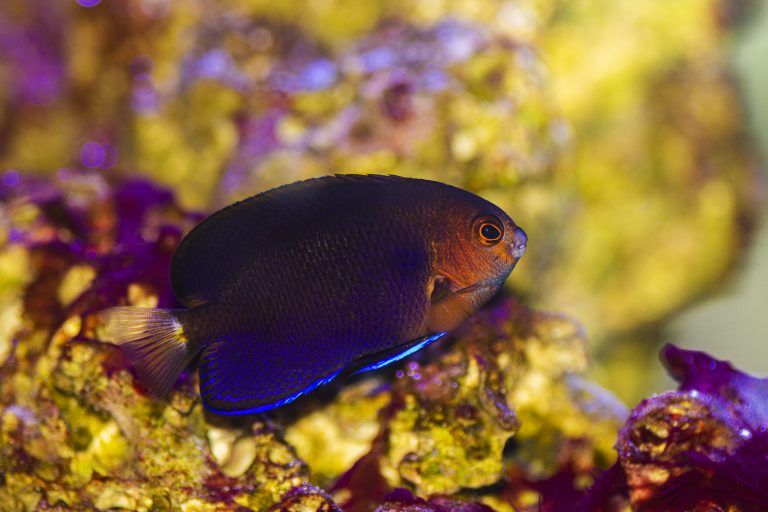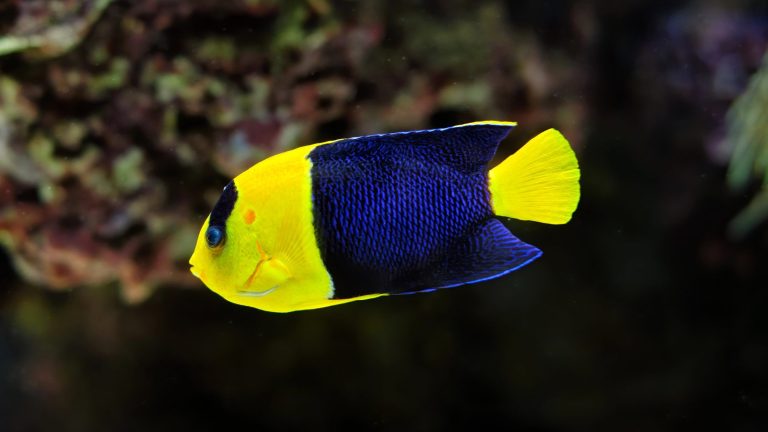The Flame Angelfish (Centropyge loriculus) is one of the most striking and popular dwarf angelfish in the saltwater aquarium hobby. Originating from the Pacific Ocean, this fish is prized for its vibrant orange-red body accented with vertical black bars and electric-blue fin edges. Hardy yet somewhat temperamental, the Flame Angel can thrive in a properly maintained marine system with ample rockwork, stable water conditions, and a balanced diet. While they bring incredible color and personality to the tank, they also come with considerations such as potential coral-nipping and territorial behavior. Each individual has their unique personality and quirks, which makes it a challenge to fully grasp their behavior. This article will discuss the general care of the Flame Angel.
Aquarium Requirements
Flame Angelfish need a well-established marine aquarium to do well. They only grow to about 4 inches in length, but I recommend keeping them in aquariums of at least 75 gallons to provide plenty of space to explore and hide. They can be kept in 55-gallon aquariums, but larger fish tanks are usually better for a fish. Provide plenty of live rock for grazing and hiding spots, as they are active swimmers but also shy at times. Dwarf angels can be incredibly elusive when first introduced. It may take them a while for your Flame Angel to become comfortable in your fish tank. A mature tank with stable water conditions is crucial to prevent stress and disease. Strong water movement and good filtration are recommended.
Is the Flame Angelfish Reef Safe?
Flame angels are considered “reef safe with caution.” While some individuals may coexist peacefully in a reef tank, others may nip at stony corals, clam mantles, and some soft corals. They are generally safer in mixed reefs with lots of coral variety and plenty of natural algae to graze on. Success often depends on the personality of the individual fish. It’s impossible to definitely say whether this fish is reef safe or not. Their temperament towards coral can change on a dime. Often, diet is a contributing factor to their coral-nipping habits.
Water Parameters
Flame Angelfish thrive in stable, reef-like water conditions. As with most dwarf angelfish, they are sensitive to sudden fluctuations in temperature, salinity, and dissolved compounds. Maintaining pristine water quality is critical to their long-term health.
Temperature: 72–82°F (22–28°C)
pH: 8.1–8.4
Salinity: 1.020–1.025 (SG)
Alkalinity: 8–12 dKH
Stable, high-quality water is key. Flame Angelfish are sensitive to poor water quality and swings in salinity or temperature. Test your water, and do it often to make sure your water parameters are in check. If you’re looking for tools to test salinity levels, consider looking at “Different Salinity Reading Tools for Saltwater Fish Tanks”
Food & Diet
Flame Angels are omnivorous grazers, feeding on a mix of algae and small meaty items in the wild. In the aquarium, their diet should be varied and nutrient-rich to maintain health, coloration, and natural foraging behavior. A poor or limited diet can lead to nutritional deficiencies, faded colors, and increased coral-nipping.
Marine Algae & Spirulina are essential for digestion and long-term health. Offer dried nori sheets clipped to the glass, spirulina-based pellets, or algae wafers. Prepared foods like frozen or pellet diets formulated for dwarf angelfish often contain sponge matter, which closely mimics their natural diet. Supplement with frozen mysis shrimp, enriched brine shrimp, finely chopped squid, clam, or krill. These provide valuable proteins for growth and coloration. Live Rock Grazing: A mature tank with live rock allows Flame Angels to naturally graze on film algae, microalgae, and small invertebrates throughout the day. This grazing behavior keeps them active and engaged.
Tank Mates
The Flame Angelfish is generally considered a semi-aggressive dwarf angelfish. While they are not as aggressive as some larger angelfish species, they can become territorial, especially in smaller aquariums or when housed with other similar-looking fish. Careful planning of tank mates and introduction order is essential. Flame Angels mix well with a variety of community-oriented reef fish, provided they are not overly timid or similar in shape. Some good tank mates include:
Clownfish
Wrasses
Gobies & Blennies
Tangs & Surgeonfish
Cardinalfish & Chromis
Some groups of fish may coexist, but require caution:
Other Dwarf Angelfish (Centropyge species). Mixing dwarf angels can lead to aggression, especially in tanks under 120 gallons. If attempted, introduce them at the same time in a very large, rock-filled aquarium.
Smaller, timid fish (e.g., firefish, dartfish). These can be bullied if the Flame Angel becomes territorial.
Other semi-aggressive species: Dottybacks, some damselfish, and hawkfish may fight for territory with a Flame Angel.
Incompatible Tank Mates
Some fish should be avoided, as they often trigger aggression or simply won’t thrive with a flame angel present:
Another Flame Angelfish. Unless you have a confirmed bonded pair, two Flame Angels will almost always fight in captivity.
Very Shy or Slow Fish (e.g., mandarins, seahorses). They can be outcompeted for food or stressed by the Flame Angel’s activity.
Aggressive Predators (groupers, lionfish, triggers)
Social Dynamics & Tips
The larger the tank, the less aggressive Flame Angels tend to be, since each fish can establish its own territory. In a small tank, aggression is magnified. Adding a flame angel after more peaceful fish are established can sometimes help, as it forces the angel to “fit in” rather than claim the entire tank. A tank with lots of caves and hiding spaces helps reduce territorial conflict, as fish can break the line of sight.
Breeding
Flame Angels are not recommended to be kept in aquariums together. This makes breeding pretty much impossible.
Final Notes
The Flame Angelfish is one of the most eye-catching additions to a saltwater aquarium, offering both beauty and personality. While not overly difficult to keep, their long-term success depends on providing a stable, mature environment, a varied omnivorous diet, and careful tank mate selection. Hobbyists should also weigh the risks of adding them to reef tanks, as some individuals may develop a taste for corals. With proper care, flame angels can thrive for years, becoming a centerpiece fish that draws attention in any marine display. As with all dwarf angelfish, patience and observation are key.
Thanks for clicking this tab, this is planned for a future feature of this website!




